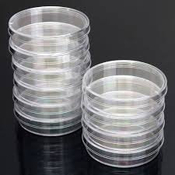Ahhh, I understand your application. Very interesting to hear that the fish glue turns out to result in the lowest level of stain. I know that Calvin ultimately resorted to clear interlayers of hardened gum to combat stain. It apparently worked extremely well and was a critical aspect of the colorful look of the examples he made with the technique. However, his work was dichromate-based (which is why he abandoned it after figuring out how to get the job done); I don't think he has done any Chiba/FAC work.
For a watery pigment dispersion, let's assume I'm making a batch of 10g dry pigment (it can be scaled up as desired) and I want to end up with a 10% w/v dispersion. I'll weigh out the 10g of pigment, then add a few drops of Orotan; something like 5 drops will be ample. Then add a little water; I'd use something like 20g or so for this amount of pigment. I do this in the plastic container of a 35mm roll of film; these seal very well as it turns out. I add a few stainless steel milling balls, then put the plastic container within the jar of my cheapskate rock tumbler and let it tumble for an hour or so. After this, I sieve out the milling balls and was the pigment into a beaker, then top up to the volume desired and put it into a wide-mouthed jar. The pigment will settle in this jar, but it can be shaken up before pipetting out the amount needed for a recipe.
Since I use this for carbon printing, I usually add a binder like gum arabic or honey (either or both work fine). But I also no longer make pigment dispersions that sit around; I produce carbon tissue in batches and just make the amount of pigment dispersion I need for that batch of carbon tissue. However, when I was experimenting a lot with pigments 1-2 years ago, I made several dispersions (some I still have sitting around) along the lines indicated above.
I tried a mortar & pestle, but the quality of the dispersion was absolutely horribly bad. A muller works much, much better and gives a reasonably OK dispersion. It also works with just Orotan and a few drops of water, but you need to keep an eye on the amount of water so the mulling works well (too dry and you're pushing around clumps, too wet and you're not dispersing the pigment effectively). The rock tumbler method described above gives far superior results to either the mortar & pestle and the mulling approach. Btw, I didn't make this up; Calvin does it this way and Sandy King et al. also describe a similar procedure in their carbon printing book. Most of my experimentation ends up confirming what others already said before (I just understand better why it works in a certain way, and what goes wrong if I ignore their advice!)



